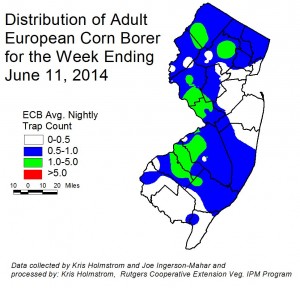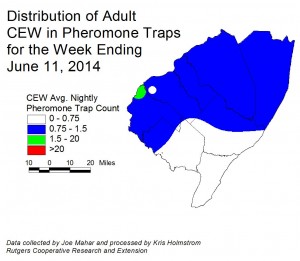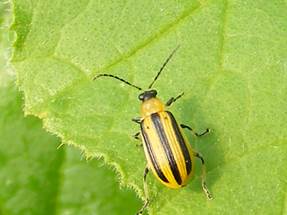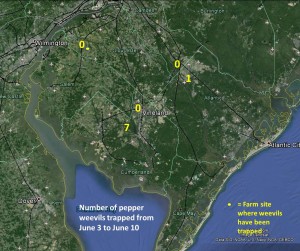Vegetable IPM Report 6-11-14 – Click to View | Download | Print
Maps for the Week
–European Corn Borer Population Map
–Corn Earworm Moth Pheromone Trap Map
–Pepper Weevil Trap Catch MapTopics for the Week
- Sweet Corn
- Cole Crops
- Peppers
- Tomatoes
- Pumpkins and Winter Squash
- Snap Beans
- Pepper Weevil Report
- BMSB
Sweet Corn
European Corn Borer (ECB) adult catches have increased throughout the state as warmer evening temperatures dominated this past several days. At present, higher activity is concentrated along the western part of the state from Sussex County south to Gloucester (see ECB map). Larval infestations in sweet corn have been detected on whorl stage corn throughout the state. Infestation rates as high as 30% were found in Ocean County this week.
Consider treating if 12% or more plants exhibit the characteristic “shot-hole” type feeding on leaves. Remember to make a full-tassel application to control ECB larvae as they leave the tassel and travel down the stalk to re-enter the plant near the ear shank. This last application is often critical to controlling ear infestations from ECB. Often, early sweet corn plantings suffer from “split set”, in which germination does not occur in a uniform fashion. The result is a planting where all plants do not reach full tassel at the same time. This situation may require an extra tassel spray if there are several days difference in the time full tassel is reached on a significant number of the plants.
| The highest nightly ECB catches for the previous week are as follows: | |||||
| Princeton | 3 | Folsom | 2 | Sergeantsville | 2 |
| Crosswicks | 2 | Long Valley | 2 | Springdale | 2 |
| Denville | 2 | Medford | 2 | Clinton | 1 |
| Downer | 2 | Pennington | 2 | Woodstown | 1 |
Blacklight Trap Corn Earworm Moth (CEW): (CEW) were captured in blacklights in Folsom and East Vineland this past week. These extremely low numbers will not result in a map image.
Pheromone Trap Corn Earworm Moth (CEW): Slightly increased catches were recorded in pheromone traps in the southern counties (see CEW pheromone trap map). Blue areas on the map correspond to a 5-day silk spray schedule. Despite the low moth numbers, sweet corn plantings now in silk in southern NJ are at risk for ear infestation if CEW is not properly controlled. As silks begin to appear, pay close attention to CEW catches in local blacklight traps, and treat silking plantings accordingly. For the present, growers in southwestern NJ whose early plantings begin to silk, should consider treating at 5-6 day intervals unless CEW catches increase.
| The highest nightly CEW pheromone trap catches are as follows: | |||||
| Pedricktown | 3 | Beckett | 1 | Elm | 1 |
| Indian Mills | 2 | ||||
Silking Spray Schedules*:
South – 5-6 days
Central – 6-7 days
*Note: These are general recommendations. Local trap catches may indicate some variation in the frequency of insecticide applications to silking corn.
Cole Crops
Heavy egg laying by Imported Cabbage Butterflies (ICW) and Diamondback Moth (DBM) continues. Infestations of these pests have been found throughout the state. Scout plantings weekly. Check 5 consecutive plants each in 10 random locations throughout the planting, paying particular attention to the innermost leaves where ICW often feed. Consider treating if caterpillars are found on 10% or more plants that are in the 0-9 true leaf stage. From 9-leaf to the early head stage (in broccoli, cauliflower and cabbage) infestations up to 20% may be tolerated. Once heads begin to form, a 5% threshold should be observed to protect the marketable portion of the plant. For leafy greens such as collards and kale, 10% plants infested is the threshold throughout. It is important to distinguish between DBM and ICW because in many cases, DBM are resistant to synthetic pyrethroid insecticides. If DBM is the dominant pest, or makes up more than a few percent of the overall infestation, consider using one of the newer chemistries. These include spinetoram (Radiant), chlorantraniprole (Coragen), and flubendiamide (Synapse/Belt). The latter two materials have the added benefit of not harming bees or predatory/parasitic insects.
Crucifer flea beetle is active on many plantings, particularly when conditions are warm. When scouting cole crops for caterpillar pests, check for the presence of flea beetles. Consider treating if flea beetles are present on 50% or more plants, and feeding injury is evident on the plants. Be sure to monitor newly emerged or transplanted fields for the presence of this pest. In general, plants like arugula and mustard (those with a “hotter” flavor) are more favorable to flea beetles.
Peppers
Pepper transplants are now in fields. At the same time, the first ECB flight is still active. Be sure to scout fields regularly for the presence of ECB egg masses. If two or more egg masses are found in a 50 plant (two leaves/plant) sample, consider treating even if no fruit are present. In the absence of fruit, ECB larvae will bore into the central stem, topping the plant. This will result in the loss of crown fruit on infested plants. Generally, where blacklight trap catches average one or more ECB per night (blue and green areas on the ECB map) and fruit are greater than ½” in diameter, insecticides are warranted. See the 2014 Commercial Vegetable Production Recommendations for materials useful in controlling ECB.
Tomatoes
Pruning and tying of plants is on-going. Remember that any event that results in contact with the plant causes numerous injuries to them (this includes hail injury). While these injuries heal, they serve as avenues of entry for bacterial pathogens that may be present either on the plants or in the field. Serious bacterial pathogens of tomato include bacterial leaf spot and bacterial canker. Both can result in unmarketable fruit, and canker can kill plants prior to the production of fruit if the infection occurs early enough. Timing and rates for applications of copper and/or the plant defense activator Actigard are detailed in the 2014 Commercial Vegetable Production Recommendations. These products provide some suppression of bacterial pathogens. It is critical, however, that spread of bacterial organisms be limited as much as possible. Avoid working in fields when plants are wet. When work is to be done in more than one planting, always work from youngest to oldest plants. This prevents workers from transporting bacteria to younger plants, where infections can result in increased crop loss. Remember that the earlier a plant is infected by a bacterial pathogen, the more likely it is to produce unmarketable fruit.
Aphid populations have also begun to appear both in the field and in high tunnel tomatoes. These pests often form colonies beneath the surface of leaves and near growing points on the plant. While the plants consist primarily of vegetative growth without fruit, aphids are largely an insignificant pest. If no broad spectrum insecticides are used on the plants, the aphids generally are decimated by predators and parasites before becoming an economic problem. Should aphid populations increase to a degree that their droppings are accumulating on the surface of developing fruit, an insecticide that specifically targets these pests may be necessary. See the 2014 Commercial Vegetable Production Recommendations for materials that are labeled for aphid control in tomatoes. Avoid broad spectrum insecticide classes such as synthetic pyrethroids as much as possible.
Pumpkins and Winter Squash
These crops are now emerging in many areas. It is important to monitor frequently for the presence of striped cucumber beetles at this time, particularly if the seed was not purchased pre-treated with an insecticide for cucumber beetle. Check 5 consecutive plants each in 10 random locations. Examine upper and lower surface of seed leaves for the presence of beetles. Consider treating if beetles are found at 5 or more sites. Heavy, but local infestations may be spot treated. Management of these pests will limit the loss of plants to the bacterial wilt disease that the beetles transmit.
A sentinel plot containing susceptible and resistant cucumber varieties, as well as muskmelons, watermelons, acorn and butternut squash and pumpkins will be established at the Snyder Research and Extension Farm in Hunterdon County. The purpose of this plot is to detect the presence of downy mildew (DM) in northern NJ. Any occurrence will be reported in this newsletter and will also generate an alert to all subscribers. For more information on the regional presence of DM as well as comprehensive, weekly forecasts, see the following website: http://cdm.ipmpipe.org/
Snap Beans
Potato leafhopper (PLH) adults have appeared in snap beans in the northern counties this week, and should be considered present in all areas. So far, only adults have been present. This pest is a particular problem because it often goes unnoticed until foliar distortion and burn occurs. Once this damage appears, yields have already been compromised. It is critical that beans be monitored regularly for the presence of PLH. If a sweep net is available, consider treating if more than 100 nymphs and adults are present in 20 sweeps of pre-bloom stage plants. This threshold increases to 250 during bloom and to 500 per 20 sweeps during pod development. If no sweep net is available, check plants in 10 random field locations and consider treating if adults and nymphs are found throughout. Adults are pale green, and will fly out from foliage when disturbed and immediately fly back into the plant canopy. Nymphs are wingless and bright green and may be found on the underside of leaves.
Pepper Weevil Report
Pepper weevil numbers continue to remain low with only 2 of the 5 locations catching weevils (see pepper weevil trap catch map). As far as known only one field so far has been infested and no weevils have been caught in that field for nearly two weeks.
The layout or location of fields of solanaceous crops and timing of initial insecticide applications may be critical in the spread of pepper weevil here. Even though a relatively large number of weevils have been trapped only one field infested at this point. In a typical year, most field infestations are found in August and September.
Brown Marmorated Stinkbug (BMSB)
Several BMSB individuals were captured in light traps this past week, although numbers remain extremely low. Adult activity is well behind in 2014. As adult captures increase to 5/night in parts of the state, maps will be produced to show where activity is highest. Information on scouting, crop injury and control will also be included.
Notes: Joe Ingerson-Mahar and Kris Holmstrom would like to acknowledge and thank the following IPM technicians for their efforts in gathering insect and disease information from around the state. Without their help, much of the information in this newsletter would be unobtainable in a timely fashion: Tonia Broen, David Carpiniello, Donna Larsen, Kamal Naphri, and Ryan Tirrell.
All current and archived Vegetable IPM Maps including European corn borer, corn earworm and brown marmorated stink bug population maps are available for viewing @
http://tinyurl.com/njaes-ipm-maps





